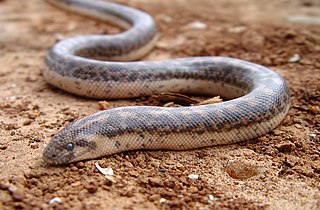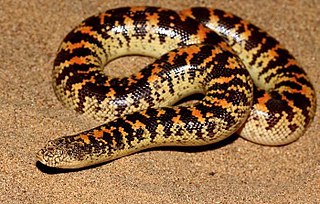
Chilabothrus exsul, the Abaco Islands boa or Northern Bahamas boa, is a boa species found in the Bahamas. No subspecies are recognized. Like all other boas, it is not venomous.

The Calabar python is a species of non-venomous snake in the family Boidae. The species is endemic to West and Central Africa. It is the only species in its genus.

Craspedocephalus strigatus, commonly known as the horseshoe pit viper, is a venomous pitviper endemic to the Western Ghats of India. No subspecies are currently recognized.
Beddome's worm snake is a species of harmless blind snake in the family Gerrhopilidae. The species is native to southern India. No subspecies are currently recognized.
Indotyphlops exiguus, the Belgaum worm snake, is a harmless blind snake species found in India. No subspecies are currently recognized.
Gerrhopilus tindalli, also known commonly as the Nilgiri Hills worm snake or Tindall's worm snake, is a species of harmless blind snake in the family Gerrhopilidae. The species is native to southern India. There are no recognized subspecies.

Craspedocephalus gramineus, known as the bamboo pit viper, Indian green pit viper, or common green pit viper, is a venomous pit viper species found in the southern and north eastern parts of India. No subspecies are currently recognized.

Eryx johnii is a species of nonvenomous snake in the subfamily Erycinae of the family Boidae. The species is endemic to Iran, Pakistan, and India. No subspecies are recognized.

Eryx conicus, also known as Russell's boa, the rough-scaled sand boa or the rough-tailed sand boa, is a species of non-venomous snake in the subfamily Erycinae of the family Boidae. The species is native to Southern Asia. No subspecies are recognised.

Eryx is a genus of nonvenomous snakes, commonly known as Old World sand boas, in the subfamily Erycinae of the family Boidae. Species of the genus are found in southeastern Europe, northern Africa, the Middle East, and southwestern Asia. Thirteen species are recognized as being valid.
Eryx elegans is a boa species endemic to western Central Asia. Like all other boas, it is not venomous. No subspecies are recognized.

The Round Island burrowing boa is an extinct species of snake, in the monotypic genus Bolyeria, in the family Bolyeriidae. The species, which was endemic to Mauritius, was last seen on Round Island in 1975. There are no recognized subspecies.

Corallus cookii, also known as Cook's tree boa or Cooke's tree boa, is a species of nonvenomous snake in the family Boidae. The species is endemic to the island of St. Vincent in the Caribbean. There are no recognized subspecies.

Eryx colubrinus, the Egyptian or Kenyan sand boa, is a species of snake in the family Boidae. The species is endemic to Northern and Eastern Africa. Three subspecies are recognized.

Chilabothrus, commonly known as the Greater Antillean boas or West Indian boas, is a genus of nonvenomous snakes the family Boidae. The genus is endemic to the West Indies. 12 or 14 species are recognized as being valid.

Eryx jaculus, known commonly as the javelin sand boa, is a species of snake in the Boidae family. It is the type species of the genus Eryx. No subspecies are recognized.

Eryx jayakari, known commonly as the Arabian sand boa or Jayakar's sand boa, is a species of snake in the family Boidae. The species is endemic to the Arabian Peninsula and Iran, where it spends the day buried in the sand. No subspecies are recognized.

Eryx miliaris, known as the dwarf sand boa, desert sand boa, or Tartar sand boa, is a species of snake in the Boidae family. The species is endemic to Asia.No subspecies are recognized.

Eryx muelleri, known commonly as Müller's sand boa or the Sahara sand boa, is a species of snake in the family Boidae. The species is endemic to Africa.

















